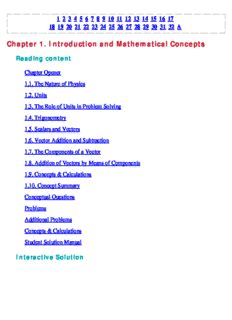
Physics, Volume 1 PDF
Preview Physics, Volume 1
1 2 3 4 5 6 7 8 9 10 11 12 13 14 15 16 17 18 19 20 21 22 23 24 25 26 27 28 29 30 31 32 A Chapter 1. Introduction and Mathematical Concepts Reading content Chapter Opener 1.1. The Nature of Physics 1.2. Units 1.3. The Role of Units in Problem Solving 1.4. Trigonometry 1.5. Scalars and Vectors 1.6. Vector Addition and Subtraction 1.7. The Components of a Vector 1.8. Addition of Vectors by Means of Components 1.9. Concepts & Calculations 1.10. Concept Summary Conceptual Questions Problems Additional Problems Concepts & Calculations Student Solution Manual Interactive Solution 1.17. Interactive Solution 1.29. Interactive Solution 1.37. Interactive Solution 1.49. Interactive Solution Concept Simulations 1.1. Vector Addition Web Links 1.1. The International System of Weights and Measures (SIPM) 1.2. Vectors Tutorial 1.3. Vector Arithmetic Java Applet 1.4. Chapter 1 Nature of Science 1.5. The Magnitudes of Physics 1.6. Freshman Chemistry Math Review Materials 1.7. Study Tips for Introductory Physics Students MCAT Review Problems Test 1 Chapter 2. Kinematics in One Dimension Reading content Chapter Opener 2.1. Displacement 2.2. Speed and Velocity 2.3. Acceleration 2.4. Equations of Kinematics for Constant Acceleration 2.5. Applications of the Equations of Kinematics 2.6. Freely Falling Bodies 2.7. Graphical Analysis of Velocity and Acceleration 2.8. Concepts & Calculations 2.9. Concept Summary Conceptual Questions Problems Additional Problems Concepts & Calculations Student Solution Manual Interactive Solution 2.17. Interactive Solution 2.29. Interactive Solution 2.31. Interactive Solution 2.47. Interactive Solution 2.49. Interactive Solution Interactive Learningware 2.1. Interactive Learningware 2.2. Interactive Learningware Concept Simulations 2.1. Constant Velocity Versus Constant Acceleration 2.2. An Accelerating Spacecraft 2.3. How High Does It Go? 2.4. One Dimensional Constant Acceleration 2.5. Problem 2.59 Graphical Analysis of Velocity Web Links 2.1. Galileo and the Mathematics of Motion 2.2. Galileo Galilei (1546-1642) 2.3. The Interactive Physics Problem Set 2.4. One-Dimensional Kinematics 2.5. One Dimensional Motion Simulator MCAT Review Problems Test 1 Video Experiments 2.1. Constant Velocity 2.2. Penny and Feather 2.3. Large Double Ball Drop Chapter 3. Kinematics in two Dimensions Reading content Chapter Opener 3.1. Displacement, Velocity, and Acceleration 3.2. Equations of Kinematics in two Dimensions 3.3. Projectile Motion 3.4. *Relative Velocity 3.5. Concepts & Calculations 3.6. Concept Summary Conceptual Questions Problems Additional Problems Concepts & Calculations Student Solution Manual Interactive Solution 3.11. Interactive Solution 3.35. Interactive Solution 3.39. Interactive Solution 3.55. Interactive Solution 3.67. Interactive Solution Interactive Learningware 3.1. Interactive Learningware 3.2. Interactive Learningware Concept Simulations 3.1. Firing a Bullet Vertically Upward from a Moving Car 3.2. Projectile Motion 3.3. Relative Velocities Web Links 3.1. Motion along a Curve 3.2. Projectile Motion 3.3. Cannon Java Applet 3.4. Galileo's Analysis of Projectile Motion 3.5. Speed and Acceleration 3.6. Relative Velocity MCAT Review Problems Test 1 Video Experiments 3.1. Bulldozer on Moving Sheet 3.2. Howitzer Cart 3.3. Simultaneous Fall 3.4. Monkey and Hunter 3.5. Projectile Gun across Room 3.6. Acceleration Cart Mass and Pulley Chapter 4. Forces and Newton's Laws of Motion Reading content Chapter Opener 4.1. The Concepts of Force and Mass 4.2. Newton's First Law of Motion 4.3. Newton's Second Law of Motion 4.4. The Vector Nature of Newton's Second Law of Motion 4.5. Newton's Third Law of Motion 4.6. Types of Forces: an Overview 4.7. The Gravitational Force 4.8. The Normal Force 4.9. Static and Kinetic Frictional Forces 4.10. The Tension Force 4.11. Equilibrium Applications of Newton's Laws of Motion 4.12. Nonequilibrium Applications of Newton's Laws of Motion 4.13. Concepts & Calculations 4.14. Concept Summary Conceptual Questions Problems Additional Problems Concepts & Calculations Student Solution Manual Interactive Solution 4.11. Interactive Solution 4.41. Interactive Solution 4.59. Interactive Solution 4.77. Interactive Solution Interactive Learningware 4.1. Interactive Learningware 4.2. Interactive Learningware 4.3. Interactive Learningware 4.4. Interactive Learningware Concept Simulations 4.1. Newton's Second Law 4.2. Static Friction 4.3. Stopping Distance of a Car 4.4. The Normal Force and the Static Frictional Force Web Links 4.1. Free Body Diagrams Tutorial 4.2. Exploring Gravity 4.3. Sir Issac Newton (1643-1727) 4.4. Inclined Planes and Frictional Forces 4.5. Newton's Cannon MCAT Review Problems Test 1 Video Experiments 4.1. Bowling Ball on a String 4.2. Breaking Brick on Chest 4.3. *Balloon Cart 4.4. Fire Extinguisher Cart Chapter 5. Dynamics of Uniform Circular Motion Reading content Chapter Opener 5.1. Uniform Circular Motion 5.2. Centripetal Acceleration 5.3. Centripetal Force 5.4. Banked Curves 5.5. Satellites in Circular Orbits 5.6. Apparent Weightlessness and Artificial Gravity 5.7. Vertical Circular Motion 5.8. Concepts & Calculations 5.9. Concept Summary Conceptual Questions Problems Additional Problems Concepts & Calculations Student Solution Manual Interactive Solution 5.3. Interactive Solution 5.24. Interactive Solution 5.31. Interactive Solution 5.41. Interactive Solution 5.53. Interactive Solution Interactive Learningware 5.1. Interactive Learningware 5.2. Interactive Learningware Concept Simulations 5.1. Uniform Circular Motion and Centripetal Force 5.2. Road Conditions and Safe Driving Web Links 5.1. Satellite Orbits 5.2. Johannes Kepler (1571-1630) 5.3. Satellite Tracking 5.4. Physics of Racing Series 5.5. Banked Curves MCAT Review Problems Test 1 Video Experiments 5.1. Waiter's Tray Chapter 6. Work and Energy
Description: